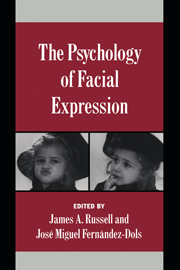Book contents
- Frontmatter
- Contents
- Foreword
- Preface
- Contributors
- Part I Introduction
- Part II Three broad theoretical frameworks
- Part III With a biological and developmental focus
- 6 Animal sounds and human faces: Do they have anything in common?
- 7 Yawns, laughs, smiles, tickles, and talking: Naturalistic and laboratory studies of facial action and social communication
- 8 A neurobehavioral approach to the recognition of facial expressions in infancy
- 9 A dynamic systems approach to infant facial action
- Part IV With a psychological and social focus
- Part V Integrative summary
- Author index
- Subject index
- Studies in Emotion and Social Interaction
9 - A dynamic systems approach to infant facial action
Published online by Cambridge University Press: 11 March 2010
- Frontmatter
- Contents
- Foreword
- Preface
- Contributors
- Part I Introduction
- Part II Three broad theoretical frameworks
- Part III With a biological and developmental focus
- 6 Animal sounds and human faces: Do they have anything in common?
- 7 Yawns, laughs, smiles, tickles, and talking: Naturalistic and laboratory studies of facial action and social communication
- 8 A neurobehavioral approach to the recognition of facial expressions in infancy
- 9 A dynamic systems approach to infant facial action
- Part IV With a psychological and social focus
- Part V Integrative summary
- Author index
- Subject index
- Studies in Emotion and Social Interaction
Summary
What does it mean when a baby smiles? Is it an expression of enjoyment, a signal to a partner that rewards effective caretaking, or simply a muscular contraction? Do physically different types of smiles indicate different things? Should the social context in which an infant smiles inform our understanding of the smile? To address these questions, we apply insights and ideas from a dynamic systems perspective to anatomical, social interactive, and neurophysiological data on the development of infant facial action (Fogel, 1993; Fogel & Thelen, 1987; Thelen, 1995; Thelen & Smith, 1994).
Two methodological and theoretical approaches to the study of facial action and to our initial questions can be identified. The Differential Emotions approach postulates that certain facial displays are expressions of discrete emotions while others are not (Ekman, 1994). The approach has generated research investigating the production (Izard, Hembree, Dougherty, & Spizzirri, 1983b) and recognition (Ekman, Friesen, & Ellsworth, 1972) of a set of facial displays thought to be prototypical expressions of a limited set of discrete emotions. The research has productively explored the physiological (e.g., Levenson, Ekman, & Friesen, 1990), cerebral (e.g., Fox & Davidson, 1988), and situational (e.g., Izard et al., 1983b) correlates of these facial displays. Using this approach, however, the coordination inherent in complex facial displays is a reality to be accepted, not a puzzle to be explored.
Is there more to facial action than displays of discrete emotion? Camras (1992) argues that a key premise of the differential perspective is that discrete emotions are associated with distinct eliciting conditions.
- Type
- Chapter
- Information
- The Psychology of Facial Expression , pp. 205 - 226Publisher: Cambridge University PressPrint publication year: 1997
- 16
- Cited by

